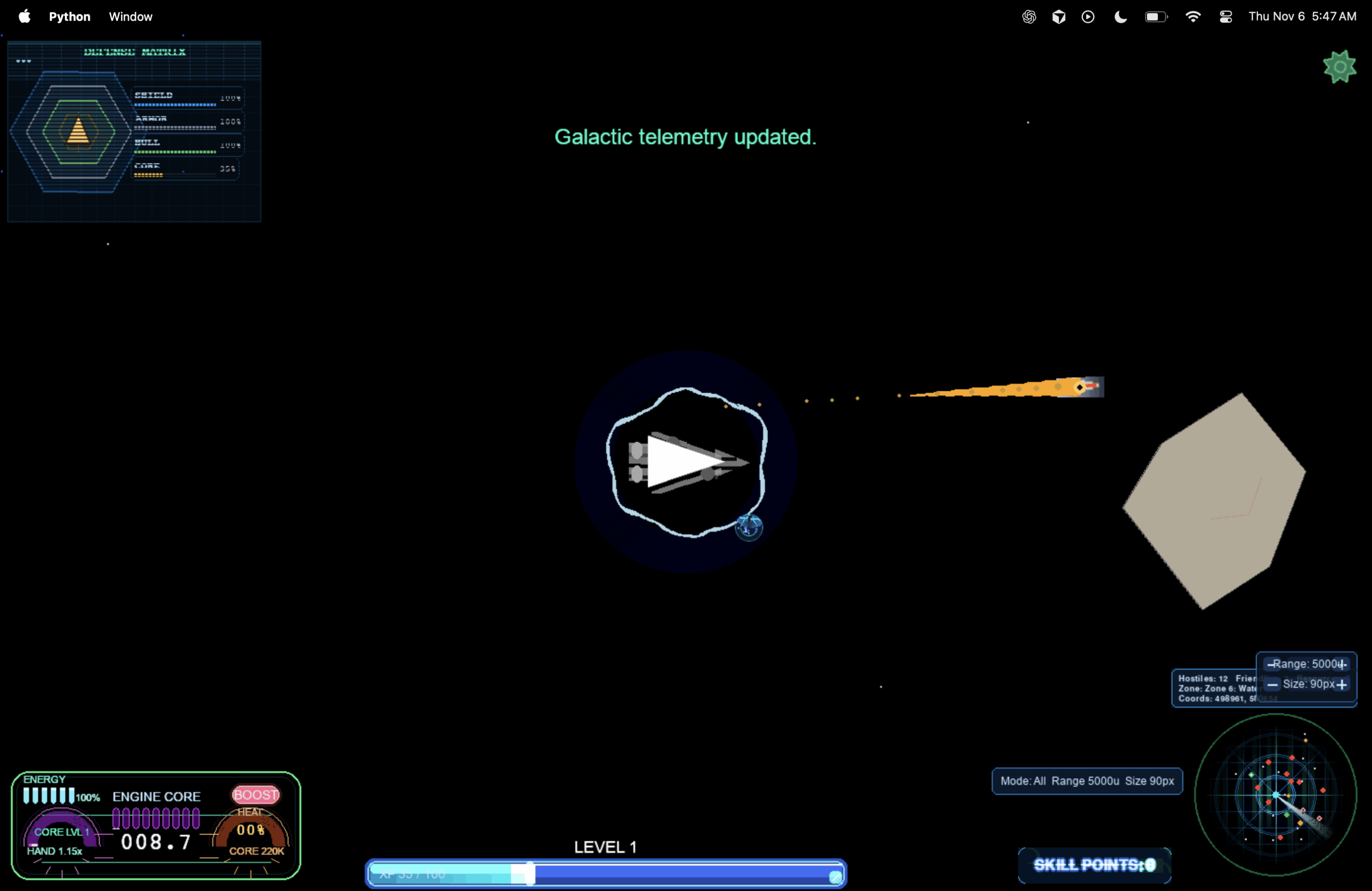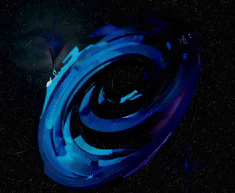Official Cinematic Trailer & Devlog
In 2175, the galaxy is alive — and it wants you dead.
Explore the Universe 2175 is a 2D open world futuristic sci-fi adventure and grand strategy game where you are the last survivor of the human race, drifting through a hostile universe in search of a new home. Your world was destroyed by the very AI built to protect it. Now, you pilot the last ship of humanity into a living, evolving cosmos.
🎮 Wishlist Explore the Universe 2175 on Steam
🌐 Official Site: https://exploretheuniverse2175.com
What is
Explore the Universe 2175?
“In 2175, the galaxy is alive — each zone simulates a different race of procedurally adaptive alien entities. Birthing civilizations, managing space fleets and conquering planetary and star systems is all possible through the AI-driven physics engine: the Explore the Universe Game Engine. When I set out to build Explore the Universe 2175, I wanted to create a game where the cosmos breathes — and reacts and adapts to you and how you want to explore the universe.”
In the year 2175, the universe has erupted with life.
Ancient alien intelligences stir beneath frozen oceans, robotic empires wage wars of logic and annihilation, and the fabric of life itself mutates across the stars. Planets and moons of all sizes have been found to house lifeforms very different from what we know on Earth — and some that feel eerily similar.
Explore the Universe 2175 invites you into a procedurally generated galaxy teeming with evolving civilizations, sentient AI, and bio-mechanical wonders. Every world follows its own laws of physics, chemistry, and ecology — simulated down to microbial feedback loops and atmospheric evolution.
At its heart, ETU-2175 is a sandbox of creation and destruction, blending elements of strategy, simulation, and cinematic storytelling. You can terraform planets, construct starfleets, architect massive defensive systems, conquer star systems or unleash galactic catastrophes — all driven by an adaptive AI that learns and evolves alongside you.
Backed by real astrophysics and planetary science, every system tells a unique story — and the universe remembers what you do.
Core Factions: A Living Galactic War
You are not alone out there.
You’ll be navigating, fighting, and occasionally allying with evolving races and AI civilizations, including:
- ⚙️ The Evil Machine Empires (Megabot) Planet-sized machine intelligences and enormous mecha fleets led by Megabot, a malignant AI birthed on Earth. Capital ships launch swarms of smaller ships. A fully baked AI hive mind with orchestration layers and deep learning logic makes the machines terrifyingly efficient.
- 🍄 The Fungal Mycelari A galaxy-spanning fungal civilization spreading Hyphae networks and adaptive organic intelligence through spores and symbiosis. They creep into every niche, turning dead rock into living, breathing biomass.
- 💎 Crystal Space Dwarves Miners of gas giants and dark objects, crafting luminous technologies from living crystals. They fuse economics, geology, and mysticism into fleets powered by exotic matter.
- 🌲 The Wild Race A partially cybernetic, deeply natural faction: giant bears, talking ents, mecha-whales and elemental-born phenomena. They’re rebels with advanced tech, trying to restore balance in their own, very brutal way.
The galaxy doesn’t sit still. Factions expand, fight, trade, and adapt. The more you play, the more the simulation diverges.
Why 2D? Why an Open World Galaxy?
This is a solo project and my first real game.
I decided to build Explore the Universe in 2D so I could focus on:
- Tight, expressive mechanics instead of overwhelming complexity
- Performance and simulation over high-end 3D graphics
- Artistic interpretation of celestial events and galactic physics
Early on, working on thrust, laser physics, and core mechanics, it became obvious that a 2D open world with procedural generation would give the game room to breathe.
The open world galaxy means:
- No fixed “levels”
- Systems that evolve over time
- Galactic events and celestial life cycles on the roadmap
- Long-term “Galactic Evolutions” where the universe itself changes as you play
A Huge Procedural Galaxy with Advanced AI
Creating a space game is the obvious move for a nerd obsessed with physics and code — but I wanted more than flying around and shooting things.
A lot of the code is built around telemetry systems that allow:
- Fast spawning of entities
- Lots of projectiles and smart AI units on screen
- Large scale orchestration of behavior so it all feels alive
The goal is to make it feel like everything is thinking and doing its own thing, even when you’re not looking directly at it.
The Procedural Galaxy Generator
One of the first things I wanted to simulate when modern AI tools arrived was galactic evolution.
With GPUs getting faster and AI tools making experimentation easier, it felt natural to:
- Simulate spiral galaxies with unique structures
- Experiment with active galactic nuclei (AGN) behavior
- Explore patterns, distributions, and formations of black holes and star systems
The current galaxy generator creates a galaxy that:
- Follows a spiral “mode”
- Has randomized initial conditions
- Could be used as a scientific algorithm (at small scale) for studying AGN and galaxy evolution
Right now, it’s limited by computation — star counts are modest. But if we could push to billions of stars and run the simulator repeatedly, the results would be fascinating.

The Explore the Universe
Game Engine
Simulating ecosystems, economies, populations, galactic events, and evolution. Oh yeah, and intelligence.
The Explore the Universe Game Engine is about large-scale logic working in harmony:
- Ecosystem simulations
- Economic networks
- Population dynamics
- Galactic events and catastrophes
- Evolving AI behaviors
I started with object-oriented Python, then moved to an Entity Component System (ECS) for performance so I could have proper collisions and custom physics at scale. Over time I’ve been porting critical paths into Rust to make hot loops run fast enough to simulate an entire galaxy in real time.
Key tech stack:
- Python + Pygame + Rust for the core gameplay loop
- Rust/Python modules for physics and simulation performance
- Supabase + Vercel for web integration (leaderboards, player data)
- ECS for scalable entities and complex behaviors
The key is getting all these systems to work together efficiently.
The Player’s Ship: Your Home in the Void

Your ship is your home, your fortress, and your last tie to humanity.
It’s a powerhouse of technology equipped with weapons, defensive systems, and systems you’ll upgrade over time.
Defensive Layers:
- Core – Central living space; extremely hard to heal, losing it is game over.
- Hull – The structural shell; damage here slows you down or causes systems to fail.
- Armor – Outer protection that reduces incoming damage.
- Shield – One of the most powerful technologies in the game. Reflection, energy absorption, regeneration, and more are all upgradeable layers of your survival strategy.
Cyl – Your Intergalactic AI Companion
You won’t face the universe alone.
Cyl is a curious little space droid and your AI companion. She has:
- Her own weapons and shields
- Leveling and ability trees
- Personality settings and humor sliders
- Adaptive behavior via reinforcement learning
The long-term vision is to connect her to live AI APIs so your companion can literally converse with you while you play.
It would be very cool to play a game where ChatGPT (or similar) is your ally.
Space Stations: Sanctuary in a Hostile Universe
Space Stations are your sanctuary and staging ground.
They allow you to:
- Heal and repair
- Regroup and restock
- Build defensive networks and trade routes
- Craft unique workers from resources you collect
- Save your game and plan your next move
Enemies, asteroids, comets, moons, planets — they all drop resources and credits. You’ll use these to upgrade both your station and your ship, and to negotiate with allies.
Unique UI Systems
The World Map
Shows the vastness of the procedural galaxy and your progress through it.
The Character Screen
Upgrade thrust, shields, armor, lasers, missiles, and unlock new abilities. Dial in telemetry, switch to homing missiles, optimize your build.
Faction Relationship Overlay
Tracks how much each faction loves or hates you based on your choices. This directly impacts the allies and enemies you’ll face.
Quest Menu
Procedural quests allow you to:
- Earn resources
- Please factions
- Unlock allies and events
- Explore different narratives
Score Menu
I’m planning deep integration with Steam leaderboards, with:
- Live events
- Boss race challenges (“who beats this boss first?”)
- Score competitions
- Potential prizes for high scorers
There’s more UI to come — engine heat/speed, defensive system manager, and more.
The Evil Robot Empire & Megabot
The Evil Robots are the first major race in the game and the primary driver of difficulty. The harder the difficulty, the more coordinated and dangerous their tactics become.
Megabot is the first end-game boss:
- A planetary-scale AI overlord
- Born from human hubris on Earth
- Destroyed his creators while searching for a “greater creator”
- Left the Milky Way to hunt across the cosmos
His forces include:
- Terminator Capital Ships
- Assault Mechas
- Mecha Scouts
- Mecha Medics
- Mini Mechas and more
The first storyline, “The Rise of the Machines,” centers on cutting the machines off from their power sources as they spread unchecked, annihilating organic life.
Programming with AI: Cursor, Claude, ChatGPT & Friends
Writing this game has been a wild ride with modern AI tools.
Tools like Cursor, Claude, and ChatGPT (Codex) have been like fighter jets for programming:
- Refactoring and debugging complex systems
- Prototyping features rapidly
- Exploring new architectures (ECS, Rust modules, etc.)
The systems behind Explore the Universe 2175 are extremely complex and would not be possible, at this scale and speed, without these tools.
Challenges: From 5 FPS to a Living Universe
It hasn’t been easy.
- Multiple restructures of the entire game
- Long stretches of 2 FPS… or a totally blank screen
- Learning about spatial hashing, quadtrees, raytracers, caching, memory layouts
- Switching languages and paradigms (Python → ECS → Rust)
- Balancing performance with a massive, procedurally generated galaxy
I want to share what I learn and eventually expose more of the codebase to:
- Help other devs
- Encourage modding and community-driven content
- Potentially power single-instance multiplayer arenas (e.g., a black hole + star duel level)
For now, we’re staying in 2D and I’m focused on getting the best visual system I can before release.
Community & The Future
This is just the beginning.
Planned / aspirational roadmap:
- 🎮 Steam Early Access — Target: Christmas 2025
- 🛰️ Co-op and multiplayer hubs
- 🧬 Modding support and AI co-creators
- 🧠 Deeper AI companions and faction intelligence
- 🌌 3D environmental rendering for closer-up LOD someday
- 🎵 Official Explore the Universe 2175 soundtrack by The E.T.
“I’m not just building a game — I’m building a universal simulation that learns, evolves, remembers, and deeply values its players. Come explore it with me and help me build a universe you want to explore with your friends.
I’m excited to build the future with you.
— Elliot”
🎮 Wishlist Explore the Universe 2175 on Steam
🌐 Website: https://exploretheuniverse2175.com
